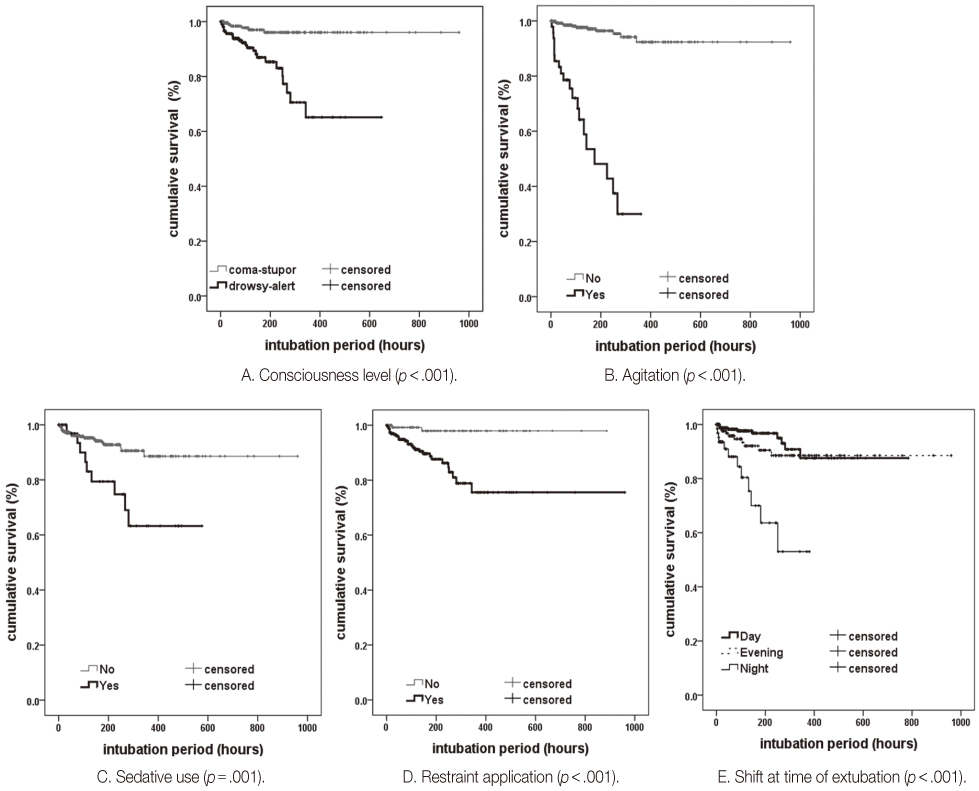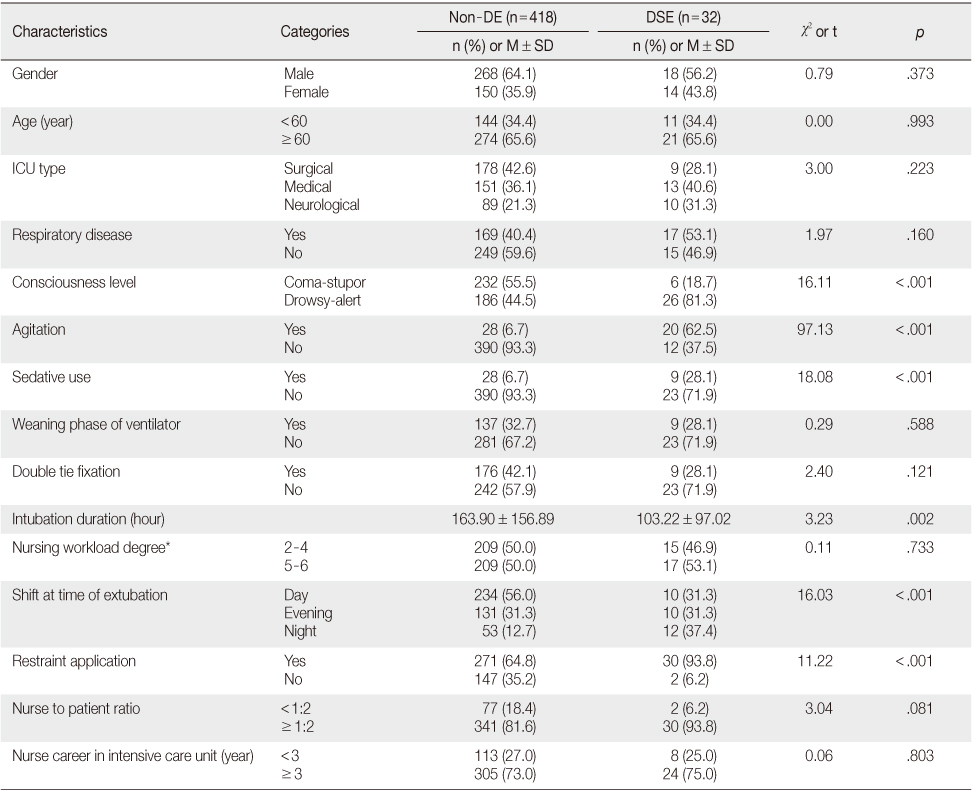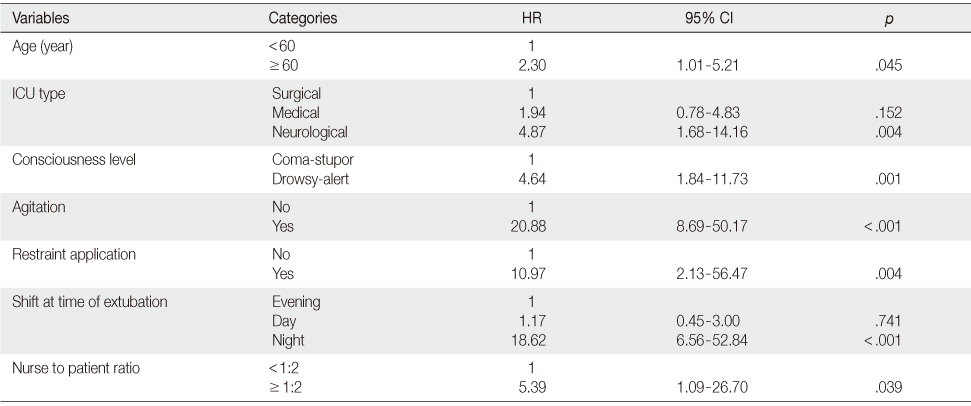Articles
- Page Path
- HOME > J Korean Acad Nurs > Volume 44(5); 2014 > Article
-
Original Article
- Risk Factors for Deliberate Self-extubation
- Young Shin Cho, Jung Hee Yeo
-
Journal of Korean Academy of Nursing 2014;44(5):573-580.
DOI: https://doi.org/10.4040/jkan.2014.44.5.573
Published online: October 31, 2014
1Surgical Intensive Care Unit, Kosin University Gospel Hospital, Busan, Korea.
2Department of Nursing, Dong-A University, Busan, Korea.
- Address reprint requests to: Yeo, Jung Hee. Department of Nursing, Dong-A University, 32 Daesingongwon-ro, Seo-gu, Busan 602-714, Korea. Tel: +82-51-240-2784, Fax: +82-51-240-2920, jheeyeo@dau.ac.kr
© 2014 Korean Society of Nursing Science
This is an Open Access article distributed under the terms of the Creative Commons Attribution NoDerivs License. (http://creativecommons.org/licenses/by-nd/4.0/) If the original work is properly cited and retained without any modification or reproduction, it can be used and re-distributed in any format and medium.
Abstract
-
Purpose
- This study was conducted to analyze intubation survival rates according to characteristics and to identify the risk factors affecting deliberate self-extubation.
-
Methods
- Data were collected from patients' electronic medical reports from one hospital in B city. Participants were 450 patients with endotracheal intubation being treated in intensive care units. The collected data were analyzed using Kaplan-Meier estimation, Log rank test, and Cox's proportional hazards model.
-
Results
- Over 15 months thirty-two (7.1%) of the 450 intubation patients intentionally extubated themselves. The patients who had experienced high level of consciousness, agitation. use of sedative, application of restraints, and day and night shift had significantly lower intubation survival rates. Risk factors for deliberate self-extubation were age (60 years and over), unit (neurological intensive care), level of consciousness (higher), agitation, application of restraints, shift (night), and nurse-to-patient ratio (one nurse caring for two or more patients).
-
Conclusion
- Appropriate use of sedative drugs, effective treatment to reduce agitation, sufficient nurse-to-patient ratio, and no restraints for patients should be the focus to diminish the number of deliberate self-extubations.
- 1. Kim JS. Nursing for prevention of unplanned extubation of endotracheal tube patients. In: 2005 The Korean Society of Quality Assurance in Health Care Fall Symposium; 2005 November 10-11; Hotel Inter-Burgo, Daegu. 2005. p. 664–665.
- 2. The Korean Society of Critical Care Medicine. Critical care medicine. 2nd ed. Seoul: Koonja; 2001.
- 3. de Groot RI, Dekkers OM, Herold IH, de Jonge E, Arbous MS. Risk factors and outcomes after unplanned extubations on the ICU: A case-control study. Crit Care. 2011;15(1):R19. http://dx.doi.org/10.1186/cc9964PubMedPMC
- 4. Birkett KM, Southerland KA, Leslie GD. Reporting unplanned extubation. Intensive Crit Care Nurs. 2005;21(2):65–75. http://dx.doi.org/10.1016/j.iccn.2004.07.012ArticlePubMed
- 5. Marino PL. Department of Anesthesiology and Pain Medicine, Yonsei University College of Medicine. The ICU book. 3rd ed. Seoul: Shinheung MedScience; 2008.
- 6. Rhee KY, Jeon YS, Eom WS, Do SH, Kim CS, Kim KW. Postoperative intubation time in patients undergoing open heart surgery. Korean J Anesthesiol. 1997;33(4):660–663.Article
- 7. Christie JM, Dethlefsen M, Cane RD. Unplanned endotracheal extubation in the intensive care unit. J Clin Anesth. 1996;8(4):289–293.ArticlePubMed
- 8. Boulain T. Unplanned extubations in the adult intensive care unit: A prospective multicenter study. Association des Reanimateurs du Centre-Ouest. Am J Respir Crit Care Med. 1998;157(4 Pt 1):1131–1137. http://dx.doi.org/10.1164/ajrccm.157.4.9702083ArticlePubMed
- 9. Bambi S. Accidental extubation in intensive care units: What implications for nursing care? Assist Inferm Ric. 2004;23(1):36–47.PubMed
- 10. Yeh SH, Lee LN, Ho TH, Chiang MC, Lin LW. Implications of nursing care in the occurrence and consequences of unplanned extubation in adult intensive care units. Int J Nurs Stud. 2004;41(3):255–262. http://dx.doi.org/10.1016/s0020-7489(03)00136-6ArticlePubMed
- 11. Kim HJ. A study on the influencing factor of unplanned extubation in MICU [master's thesis]. Seoul, Chung-Ang University. 2005.
- 12. Choi YK. A study on the influencing factor of unplanned endotracheal extubation in ICUs [master's thesis]. Seoul, Seoul National University. 2002.
- 13. Chevron V, Menard JF, Richard JC, Girault C, Leroy J, Bonmarchand G. Unplanned extubation: Risk factors of development and predictive criteria for reintubation. Crit Care Med. 1998;26(6):1049–1053.PubMed
- 14. Listello D, Sessler CN. Unplanned extubation. Clinical predictors for reintubation. Chest. 1994;105(5):1496–1503.ArticlePubMed
- 15. Ayllón Garrido N, Rodríguez Borrajo MJ, Soleto Paredes G, Latorre García PM. Unplanned extubations in patients in the ventilator weaning phase in the intensive care unit: Incidence and risk factors. Enferm Clin. 2009;19(4):210–214. http://dx.doi.org/10.1016/j.enfcli.2009.02.006PubMed
- 16. da Silva PS, Fonseca MC. Unplanned endotracheal extubations in the intensive care unit: Systematic review, critical appraisal, and evidence-based recommendations. Anesth Analg. 2012;114(5):1003–1014. http://dx.doi.org/10.1213/ANE.0b013e31824b0296PubMed
- 17. Curry K, Cobb S, Kutash M, Diggs C. Characteristics associated with unplanned extubations in a surgical intensive care unit. Am J Crit Care. 2008;17(1):45–51.ArticlePubMedPDF
- 18. Lee JJ, Lee KM, Lee YB, In BM, Um DJ, Choi R. Unplanned extubation and factors affecting reintubation in ICU patients. Korean J Crit Care Med. 1996;11(2):179–183.
- 19. Ahn JO. Statistical analysis of biomedical data using SPSS 18.0: In EMR & PHP system. Seoul: Hannarae Publishing Co.; 2010.
- 20. Cho YA, Shin HJ, Cho JK, Jung MK, Lee BN, Song KJ. Development and application of the workload management system for critical care nurses (WMSCN) using WMSN. Clin Nurs Res. 2005;11(1):71–84.
- 21. Kim JS, Lee ES. The effect of nursing intervention on communication improvement for patients with endotracheal intubation. Clin Nurs Res. 2007;13(3):7–17.
- 22. Park SI, Yun HY, Chon HK, Lee JH, An SM, An HC, et al. The effects of using computer-based communication methods for intubated patients. Clin Nurs Res. 2007;13(1):65–77.
- 23. Moon KJ, Lee SM. Development of an evidence-based protocol for preventing delirium in intensive care unit patients. J Korean Clin Nurs Res. 2010;16(3):175–186.
- 24. Bray K, Hill K, Robson W, Leaver G, Walker N, O'Leary M, et al. British association of critical care nurses position statement on the use of restraint in adult critical care units. Nurs Crit Care. 2004;9(5):199–212.ArticlePubMed
- 25. Kim JS, Lee ES, Park JH. Effects on unplanned extubation, oral mucosa, and facial skin integrity of new method to secure endotracheal tube. J Korean Clin Nurs Res. 2009;15(3):49–59.
- 26. Koh SO, Park PH, Kong MH, Kim YL. The distribution of medical personnel and medical equipments in the intensive care units in Korea. Korean J Crit Care Med. 2001;16(2):138–143.
- 27. Berger AM, Hobbs BB. Impact of shift work on the health and safety of nurses and patients. Clin J Oncol Nurs. 2006;10(4):465–471. http://dx.doi.org/10.1188/06.cjon.465-471ArticlePubMed
REFERENCES
Figure & Data
REFERENCES
Citations

- Results of Applying a Ventilator Weaning Protocol Led by an Advanced Practice Nurse for Cardiac Surgery Patients
YoungJu Eim, Su Jung Choi
Journal of Korean Critical Care Nursing.2024; 17(2): 42. CrossRef - Risk Factors associated with Unplanned Removal of Nasogastric Tubes in Neurocritical Patients
Jaejin Kang, Yang-Sook Yoo
Korean Journal of Adult Nursing.2022; 34(2): 158. CrossRef - Incidence of Unplanned Extubation and Related Factors of Reintubation in the Neonatal Intensive Care Unit
Hee Moon Lim, Hyejung Lee, Mi Jung Park, Jeong Eun Shin
Journal of The Korean Society of Maternal and Child Health.2022; 26(2): 72. CrossRef - Unplanned Extubation as a Prognostic Factor in Critically Ill Patients: A Systematic Review and Meta-analysis
Takeshi Unoki, Hideaki Sakuramoto, Shunsuke Taito, Yuki Kataoka
Annals of Clinical Epidemiology.2021; 3(3): 78. CrossRef - Nurses’ Experiences of Patients’ Safety Accidents
Yujin Hur, Miha Chung, Jinyoung Lee
The Korean Journal of Rehabilitation Nursing.2021; 24(2): 131. CrossRef - Self-extubation in patients with traumatic head injury: Determinants, complications, and outcomes
SaeedA Mahmood, OmaimaS Mahmood, AymanA El-Menyar, MohammadM Asim, AhmedAbdel-Aziz Abdelbari, TalatSaeed Chughtai, HassanA Al-Thani
Anesthesia: Essays and Researches.2019; 13(3): 589. CrossRef - Unplanned Extubation in Patients with Mechanical Ventilation: Experience in the Medical Intensive Care Unit of a Single Tertiary Hospital
Tae Won Lee, Jeong Woo Hong, Jung-Wan Yoo, Sunmi Ju, Seung Hun Lee, Seung Jun Lee, Yu Ji Cho, Yi Yeong Jeong, Jong Deog Lee, Ho Cheol Kim
Tuberculosis and Respiratory Diseases.2015; 78(4): 336. CrossRef

Figure 1
Characteristics related to Deliberate Self-extubation of the Participants (N=450)
*was measured by Workload Management System for Critical Care Nurses; D(S)E=Deliberate (self) extubation; ICU=Intensive care unit.
Risk Factors for Deliberate Self-extubation (N=450)
ICU=Intensive care unit; HR=Hazard ratio; CI=Confidence interval.
*was measured by Workload Management System for Critical Care Nurses; D(S)E=Deliberate (self) extubation; ICU=Intensive care unit.
ICU=Intensive care unit; HR=Hazard ratio; CI=Confidence interval.
 KSNS
KSNS
 E-SUBMISSION
E-SUBMISSION



 Cite
Cite

